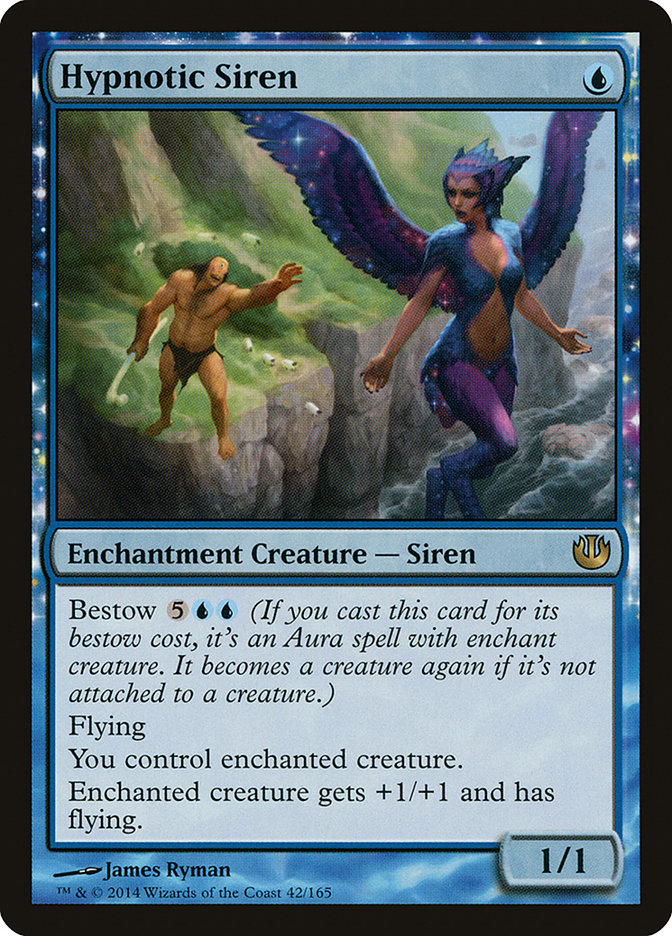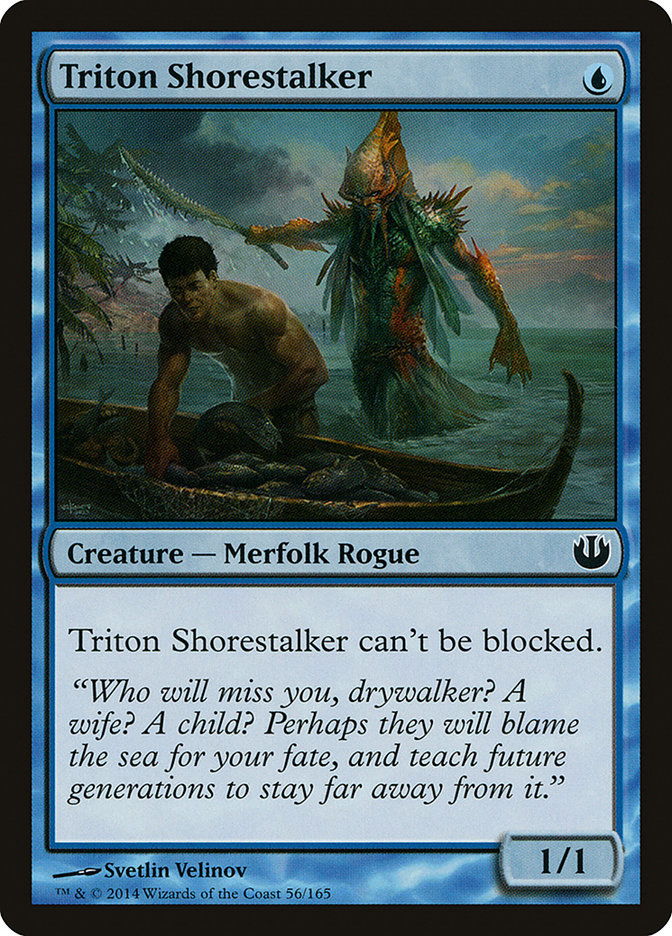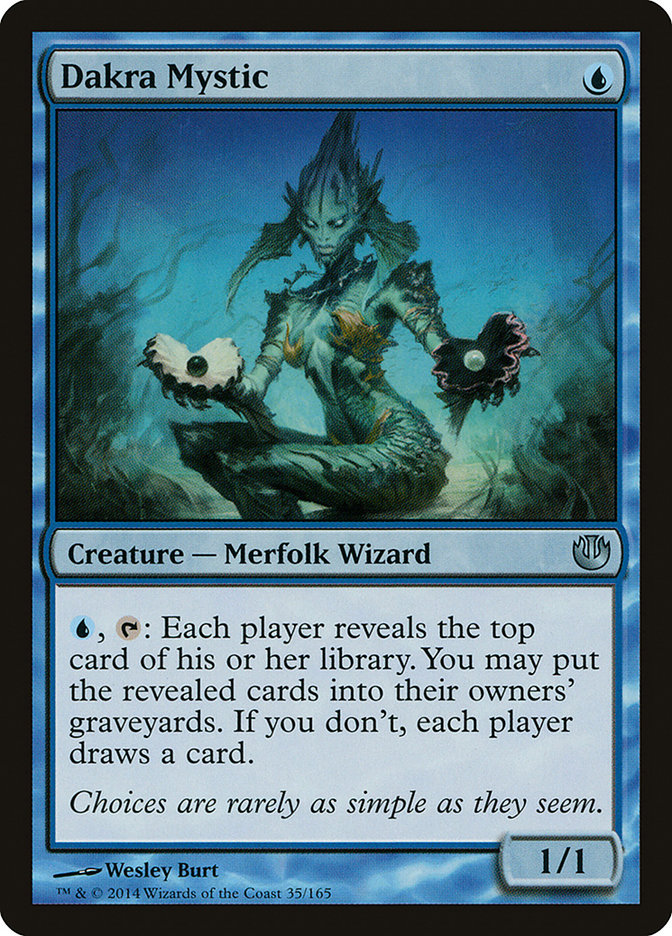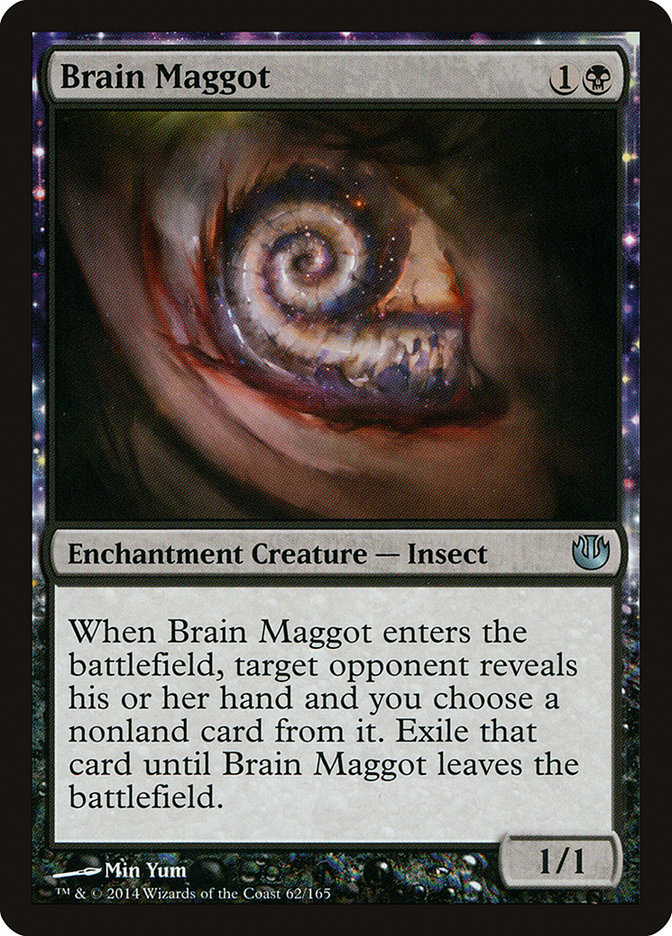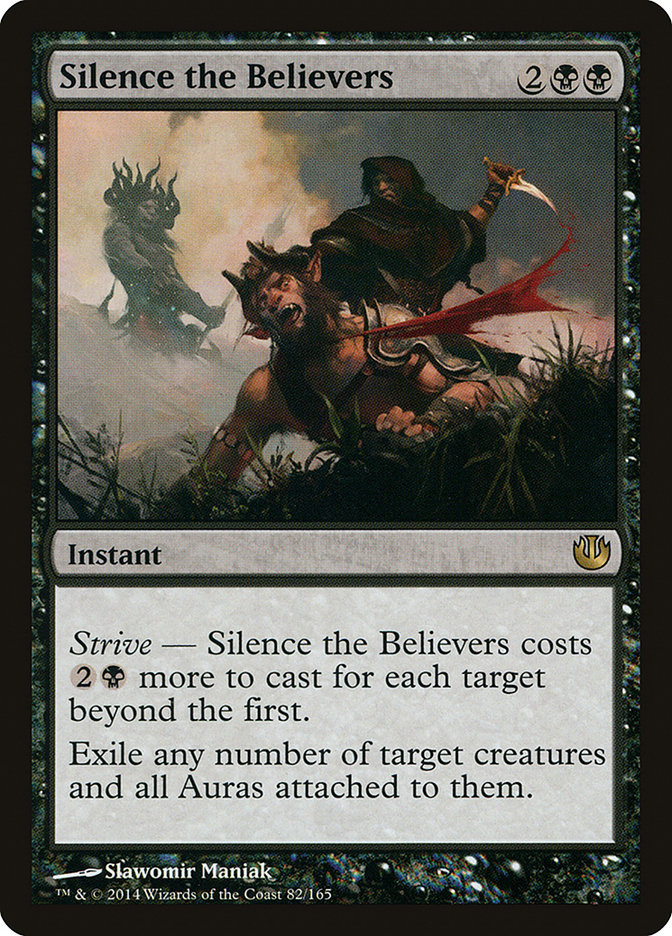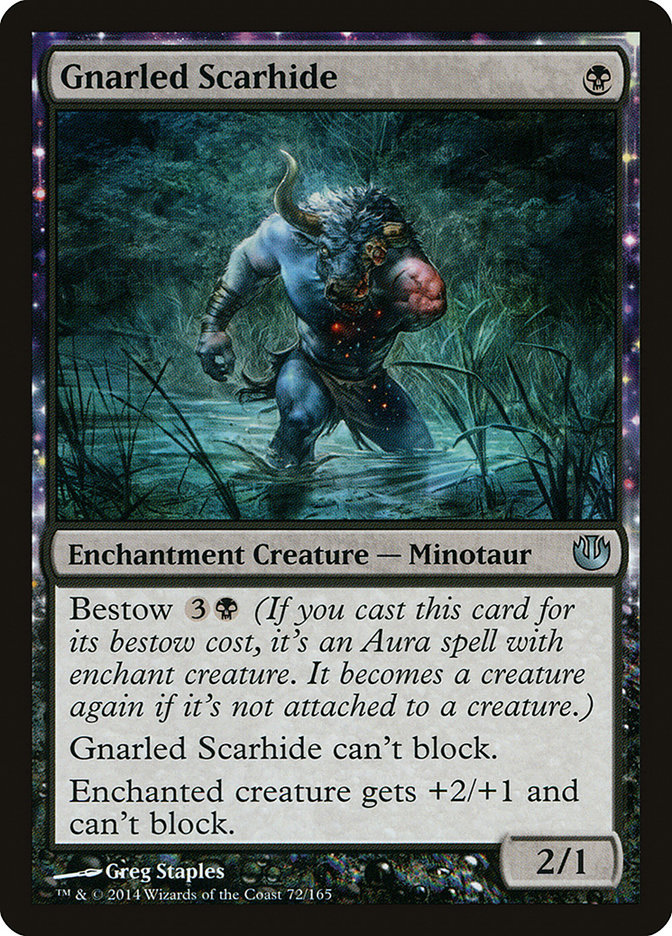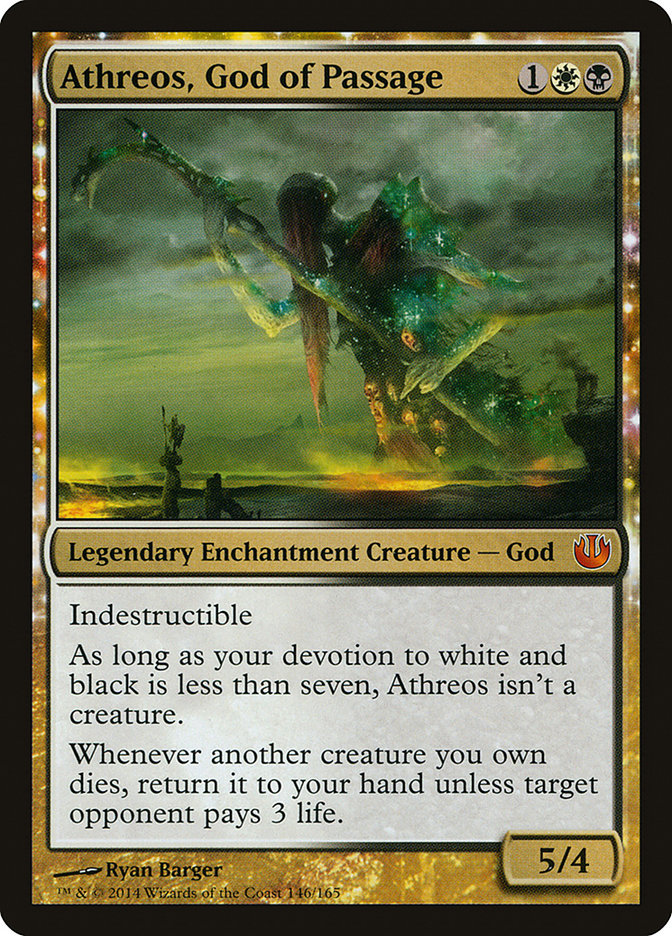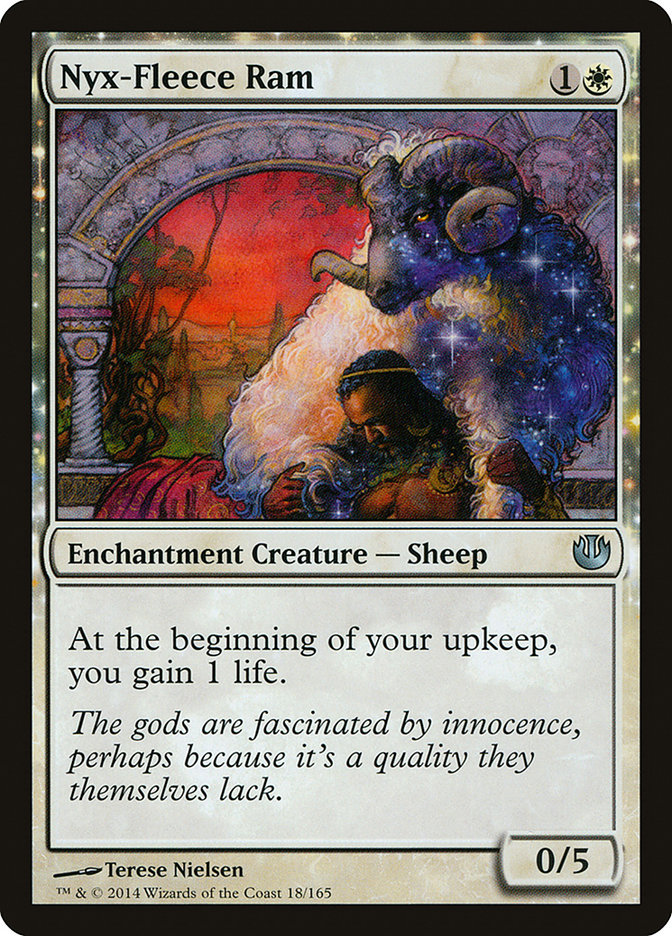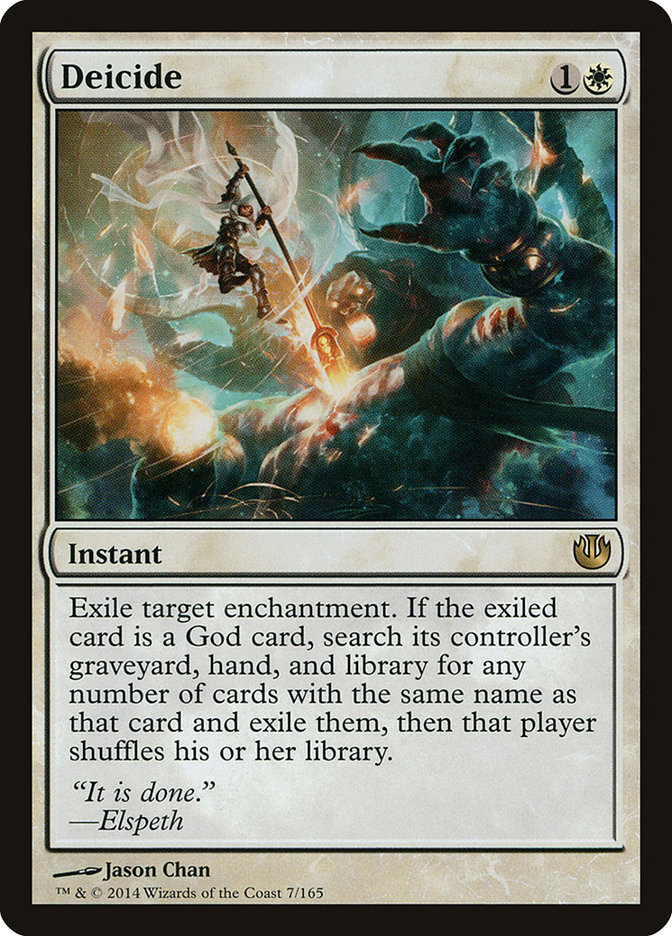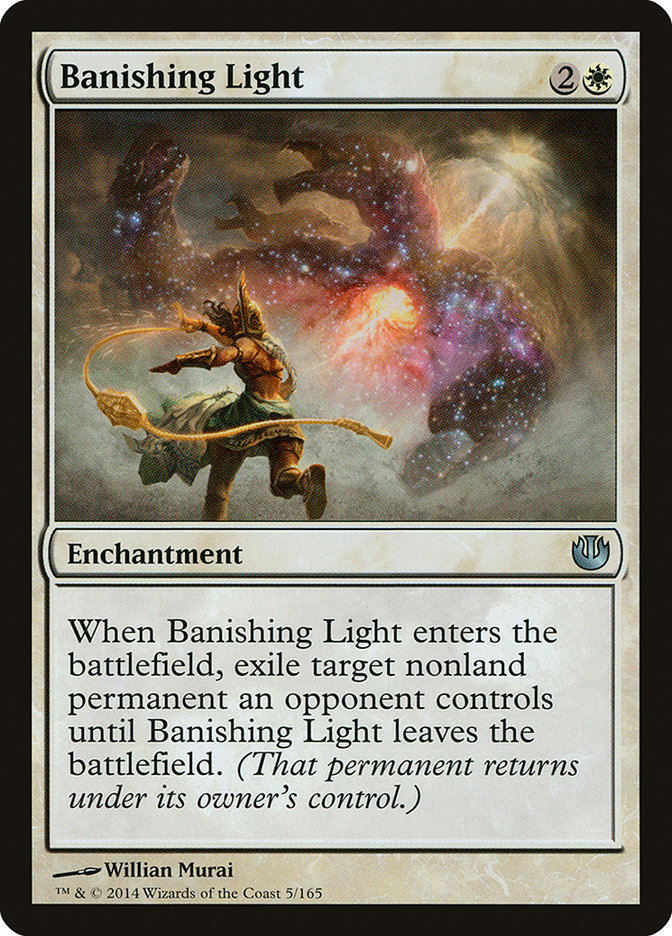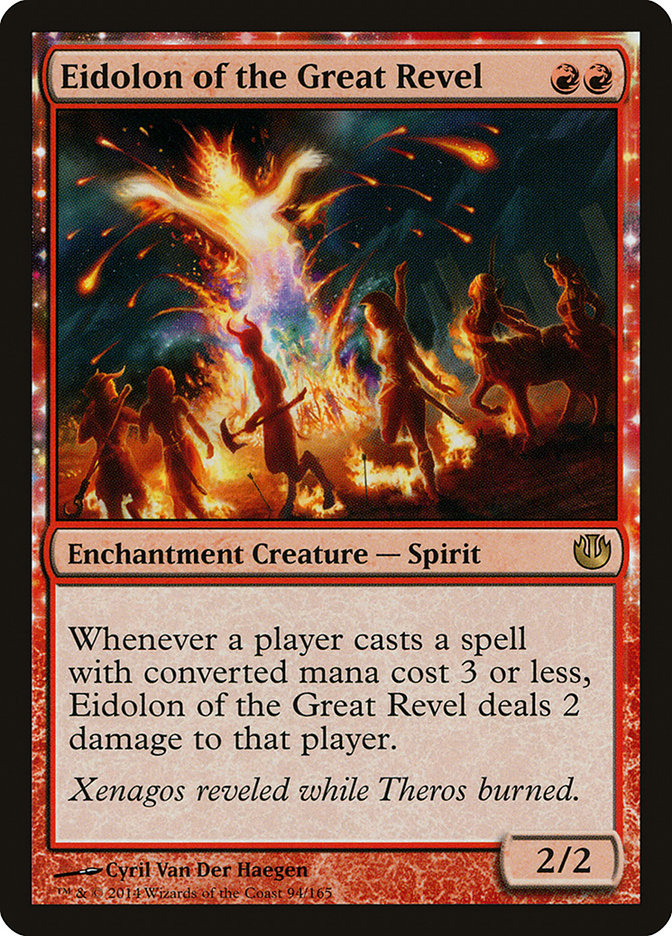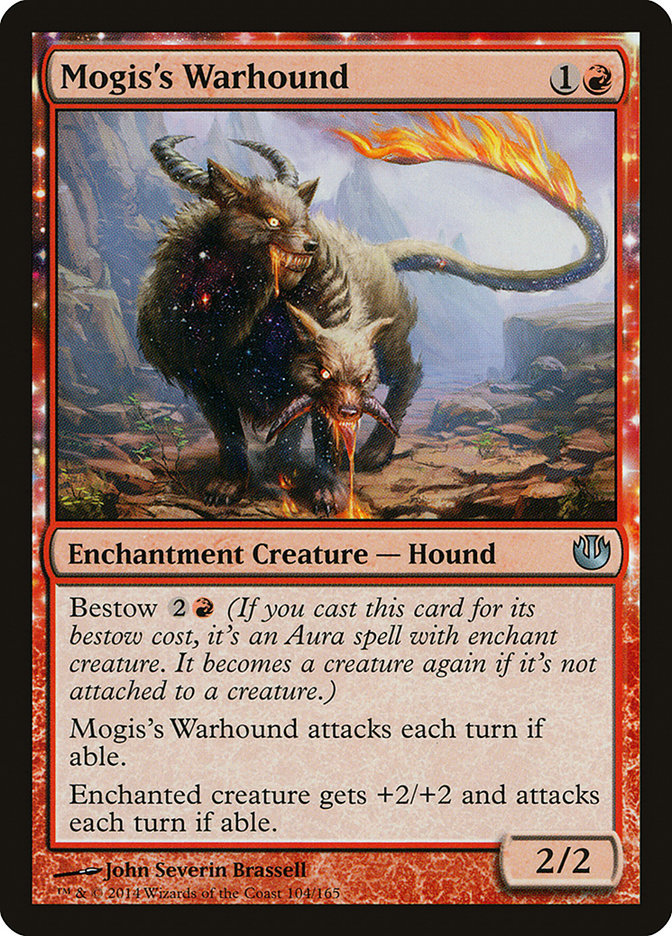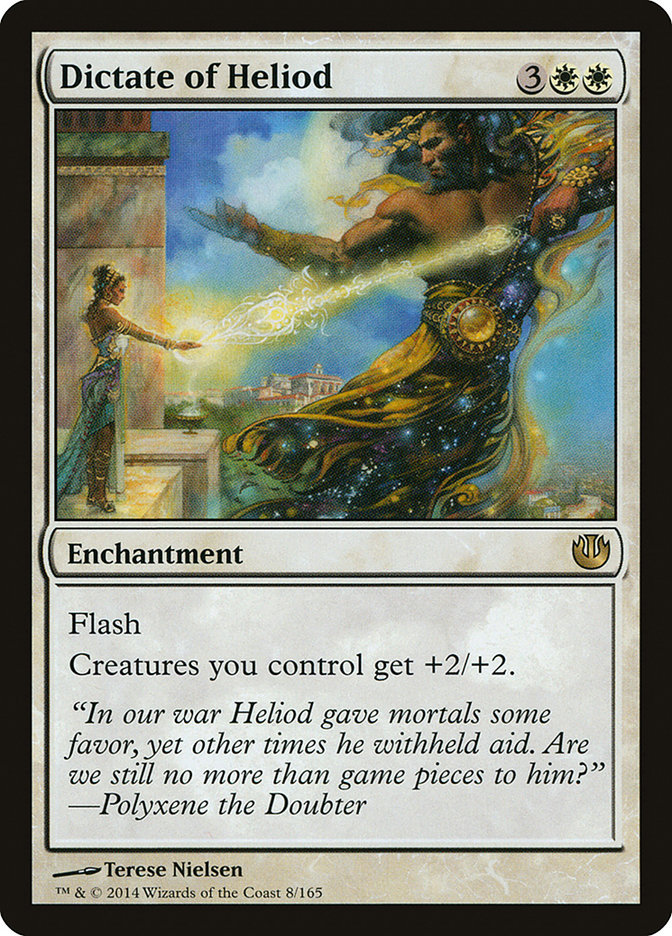You sit down to draft. You open your first pack . . .
All fifteen Gods.
Which one do you first pick? And which one will wheel?
. . .
Journey into Nyx is awesome.
I love brewing with the new cards every time a new set comes out, but it’s doubly fun when it is a fun set, a powerful set, a set full of cards that actually add dimensions to the format.
Obviously, most of the paths will turn out to be dead ends. That’s how these things go. There isn’t solid gold beneath every single rock we look under. We might try 30 new deck concepts, only to find just three of them have what it takes to cut it in high-level events.
The format isn’t just going to be brand-new archetypes however. In order to brew properly, we need to have an idea of what the format will look like, what the field is we need to compete with. Besides, if we don’t find something sick, we want to have access to updated versions of all the major decks.
To this end, today’s focus is on updates to existing archetypes. This isn’t to say that it will just be the one card that gets added to Mono-Blue Devotion, Mono-Black Devotion, Esper Control, G/R Monsters, and R/W Burn; I will also touch on a lot of tier 2 and fringe decks, hoping that they gain enough to help them climb up the ladder. I’ll be back on Wednesday to dive into the many completely new strategies made possible by Journey into Nyx cards.
Where to start with Standard?
How about with the format’s step 1: Mono-Blue Devotion.
Mono-Blue Devotion came out the gates blazing, dominating Pro Tour Theros. While the format managed to adapt, Mono-Blue Devotion never really fell out of the first tier. Then Born of the Gods came along, and sure enough Mono-Blue Devotion got almost zero cards. Many tournaments have been won after Born of the Gods with Mono-Blue Devotion decks featuring zero cards from the set.
The only card Mono-Blue Devotion got was a better counterspell in Thassa’s Rebuff, but unfortunately counterspells aren’t even something the deck is interested in anymore. They also gained access to Ephara, God of Polis and Temple of Enlightenment, but that spawned a new deck more than updated an existing one.
Journey into Nyx has at least three cards that need to be seriously considered for Mono-Blue Devotion, and amusingly all three are fighting for the same spot. Cloudfin Raptor is excellent, but let’s be serious—Judge’s Familiar is aggressively mediocre.
*pfft*
And just like that blue has three new options at the one spot.
Creatures (29)
- 4 Frostburn Weird
- 4 Cloudfin Raptor
- 4 Nightveil Specter
- 4 Tidebinder Mage
- 4 Thassa, God of the Sea
- 4 Master of Waves
- 2 Hypnotic Siren
- 3 Triton Shorestalker
Planeswalkers (1)
Lands (25)
Spells (5)

There’s nothing that actually says we need to play exactly eight one-drops. In fact, mana curve-wise we’d rather have ten. Maybe it will just seem silly to have ever had a list without four copies of Triton Shorestalker, but it’s Hypnotic Siren that actually has me excited.
Hypnotic Siren mostly functions as a Judge’s Familiar (in that it is a 1/1 flier), but it has the option to “kick it” and get a Control Magic (plus a buff to that creature, plus 1/1 flier if things go south). Seven may seem like a lot of mana, but Nykthos, Shrine to Nyx can make this a reality surprisingly early. Besides, Mono-Blue Devotion is prone to flooding, so having more to do with your extra mana is always appreciated.
Hypnotic Siren does carry with it a serious risk. It is an enchantment creature, meaning Destructive Revelry and Deicide have another target. This isn’t the end of the world by any means, but it is a real cost, particularly with just how many people will have enchantments in their deck now.
What about Triton Shorestalker?
What about it?
You know what you’re getting. With as many fliers as the format currently features, it is not trivial, upgrading your flying to unblockability. It does slightly push you to play more Bident of Thassa than you otherwise would, but this is basically a clean minor upgrade. The sacrifice ability on Judge’s Familiar is just not that big a deal.
As for Dakra Mystic, I might have been interested if not for the increased competition. Having summoning sickness and then requiring mana to use each turn are some very real costs. I generally like the card, but I think we’re better served playing a tempo-oriented game with the difficult to block creatures. Dakra Mystic is going to show up in a few places, perhaps in Modern Merfolk, but I doubt Standard Mono-Blue Devotion is the place for it.
Mono-Blue Devotion is a very tight package, so it’s hard to squeeze new cards in; however, the prospect of more good one-drops than we can possibly play could change some of our basic assumptions. I don’t think the deck really gains anything besides one-drops, but this is more cards than I thought we would realistically have to choose from.
Mono-Black Devotion was already one of the absolute best decks before Born of the Gods, and the printing of Bile Blight and Drown in Sorrow only further cemented it. Journey into Nyx is unlikely to completely revolutionize Mono-Black Devotion, but it does have some reasonable options.
Brain Maggot is a callback to Mesmeric Fiend, though unfortunately (for this particular deck anyway) it is now also vulnerable to enchantment removal. The long and short of it however is now black has access to even more Thoughtseize effects than before. Thoughtseize into Brain Maggot is a really effective way to cripple an opponent, and even when Brain Maggot can’t take their best card for good, it can mess up the order your opponent was looking to play their cards.
Silence the Believers is a pretty wild card. We already had access to hard creature kill for three in Hero’s Downfall. While most removal spells are a question of what drawbacks and limitations they possess in exchange for costing two, Silence the Believers is actually about what advantages you get in exchange for costing four.
Silence the Believers not only kills any creature (other than a Blood Baron of Vizkopa for the most part), but it also:
- Kill Gods when they wake up, such as Thassa, God of the Sea; Ephara, God of Polis; and Erebos, God of the Dead.
- Creatures exiled by it aren’t coming back, such as Chandra’s Phoenix; Jarad, Golgari Lich Lord; and those that would be combined with Whip of Erebos.
- The creature exiled doesn’t trigger death triggers, such as Xathrid Necromancer.
- Any bestow creatures that were attached to the exiled creatures are gone as well, such as Boon Satyr, Herald of Torment, and Eidolon of Countless Battles.
- Silence the Believers has multi-kicker, so later in the game you can actually get a two-for-one, maybe even a three-for-one out of it.
It’s hard to justify four-mana removal, but Silence the Believers does so much that we really do need to try it. Hell, it’s possible we want to work a Nykthos, Shrine to Nyx in here if we end up with a few ways (like this) to use the mana profitably. It would make Nightveil Specter better anyway.
Creatures (17)
Lands (26)
Spells (18)
- 4 Thoughtseize
- 4 Underworld Connections
- 3 Devour Flesh
- 4 Hero's Downfall
- 2 Bile Blight
- 1 Silence the Believers
Sideboard

Even though Silence the Believers may prove so versatile and strong that we want more, the first copy makes sense. It does have diminishing returns, and having one gives us a tool very different than what we used to have. On the other hand, Brain Maggot is pretty random as a one-of. I mean, obviously if we just cut Pack Rat, we’d have a ton of room. I am hesitant to however without actually testing the format and finding that they are underperforming. They just seem like they should still be fine I guess.
So why one Brain Maggot at all? Well, if we played zero, we’d never draw it! We want to learn about what it does for us within the context of the classic black shell. It’s very possible that we fall head over heels for Brain Maggot and redesign some element of the deck.
The shell I am even more excited to try Brain Maggot in is Mono-Black Aggro, which also gains a great deal from this little number:
A third black one-drop with a power of two is huge for Mono-Black Aggro. If Gnarled Scarhide was just a 2/1 that couldn’t block, we’d already be in the market for it, but it has two great abilities. First, it has “kicker” 3, where if you spend three extra mana you get a 2/1 haster that might be able to get a creature through that otherwise would not have been able to. For instance, if your opponent has a Nightveil Specter, it is pretty awesome to be able to turn your Pain Seer into a 4/3. Then if that creature gets dealt with, you get another 2/1 creature as a bonus.
Second, Gnarled Scarhide can be used as a makeshift removal spell from time to time. It isn’t always ideal, but sometimes making one of your opponent’s creatures unable to block can help punch through the killing blow.
Creatures (29)
- 4 Rakdos Cackler
- 4 Lifebane Zombie
- 4 Tormented Hero
- 1 Mogis's Marauder
- 4 Pain Seer
- 4 Herald of Torment
- 4 Gnarled Scarhide
- 4 Brain Maggot
Lands (22)
Spells (9)
Sideboard

Mono-Black Aggro was already in a pretty good spot but lacked a third one-drop, and its second two-drop was kind of loose. Gnarled Scarhide and Brain Maggot are the perfect additions, making Mono-Black Aggro one of the most likely candidates to jump tiers. The cumulative effect of four copies of Thoughtseize, four copies of Brain Maggot, and four copies of Lifebane Zombie plus a playset of Duress in the board adds up to a completely ruthless disruption package.
While it is much less important than the above two cards, Agent of Erebos is a fine sideboard option that gives Mono-Black Aggro a powerful tool against G/B Dredge decks if it gets big. Exiling their graveyard when it comes into play is already pretty awesome, but then you get to run it back every time you cast a Gnarled Scarhide, Brain Maggot, or Herald of Torment. Between Pharika, God of Affliction; Strength from the Fallen; Kruphix’s Insight; Nyx Weaver; Temple of Malady; and Mana Confluence, few decks stand to gain anywhere near as much as G/B ones, so we might be seeing a lot more of them in the days to come.
Cast into Darkness isn’t a terrible option, but not being instant speed is kind of brutal. Besides, we have such good options that we’d only want this over Ultimate Price / Doom Blade / Bile Blight types if we specifically wanted more enchantments or if we were trying to get enough devotion to wake up Erebos, God of the Dead.
One element of Gnarled Scarhide that most don’t realize is that it is a Minotaur. When we were discussing Born of the Gods (and its various Minotaur lords), we lamented the lack of a one-drop Minotaur.
Creatures (28)
- 4 Rageblood Shaman
- 4 Kragma Warcaller
- 4 Deathbellow Raider
- 4 Ragemonger
- 4 Felhide Brawler
- 4 Gnarled Scarhide
- 4 Felhide Petrifier
Lands (24)
Spells (8)

With both Gnarled Scarhide and Thoughtseize at one, something had to give on the mana. In this case, Boros Reckoner and by extension Fanatic of Mogis ended up biting the bullet. I’m not totally sure how I feel about the two best creatures in the deck (in the abstract) being the two that got cut, but I don’t know that it is horrible. Having a good one-drop is just so important.
Felhide Petrifier is a more powerful addition than it may appear. A 2/3 deathtoucher is already a kind of real thing for three mana, but giving it to all your other Minotaurs is actually pretty awesome. First, now you can attack with impunity—Sylvan Caryatid no longer blocks, fatties don’t Moat you, and it can be very difficult for people to double block you. Secondly, combining Rageblood Shaman with Felhide Petrifier is a mondo combo that makes all of your creatures mostly unblockable since trample + deathtouch means it takes just one damage to kill a blocker with the rest trampling over.
The only problem with this plan is the double red in Rageblood Shaman’s cost. Fourteen sources is a little light for such demands. Fortunately, Ragemonger gives us a virtual fifteenth, sixteenth, seventeenth, and eighteenth source for the second red if it lives.
It may be tempting to use Mana Confluence instead of Rakdos Guildgate, but I think people may be underestimating how much all that damage adds up. Mana Confluence is much more for one-drop aggro decks. This list is going to waste its first turn a pretty hefty chunk of the time anyway.
Another possible application of Gnarled Scarhide is to help support a very aggressive W/B Aggro deck. Using tons of one-drops in both white and black would not be possible if not for Mana Confluence, so there is reason for this deck to be able to use both now (instead of having to pick a color to have one-drops in).
Creatures (36)
- 4 Dryad Militant
- 4 Rakdos Cackler
- 4 Boros Elite
- 2 Banisher Priest
- 3 Xathrid Necromancer
- 4 Tormented Hero
- 4 Soldier of the Pantheon
- 4 Gnarled Scarhide
- 3 Athreos, God of Passage
- 4 Brain Maggot
Lands (20)
Spells (4)
Sideboard

This isn’t the greatest mana base in the world but is going to be fairly reliable, and with twenty-four one-drops that hit hard, hopefully our opponents will generally be on the back foot too much to take advantage of all of the damage we are doing to ourselves.
I am super excited about Athreos, God of Passage, which I suspect will be one of the Top 5 cards in the set. Its ability is pretty incredible for just three mana. Imagine the sequence of one-drop into two more one-drops (which will be normal for this deck). If you drop Athreos on turn 3, what is your opponent going to do? Now each Doom Blade costs them three life. Supreme Verdict is extraordinarily painful! While it will get hit by Deicide or Detention Sphere some of the time, the card is going to singlehandedly win a ton of games when they don’t have it.
Besides, it is not unreasonable to wake up and hit as hard and as fast as Thassa, God of the Sea! Athreos’ ability actually helps enable devotion a fair bit since it promotes a board stall instead of trying to kill all of your creatures. Figuring out how to tune our B/W decks to take advantage of this is one of the most important deckbuilding challenges facing us in the weeks to come.
While we are on the topic of Orzhov, we might as well put together a B/W Midrange deck with updates.
Creatures (14)
Planeswalkers (2)
Lands (26)
Spells (18)

I’m not at all sure that Brain Maggot is what we want, but it does work well with Blood Baron of Vizkopa, taking the one answer they would have had. On the other hand, Nyx-Fleece Ram is a huge boon. That card is really hard for Mono-Red Aggro to deal with, and even R/W Burn struggles when they don’t have Chained to the Rocks. Besides, it is a totally reasonable blocker against fast white or black aggro decks, effectively stopping an attacker per turn while also netting extra life (to potentially help fuel Underworld Connections or just stay alive).
It is not clear if we want Silence the Believers, but it does play into the midrange-control plan pretty well. Often spending four to kill a creature isn’t even that bad, but if you ever kill a Thassa, Chandra’s Phoenix, or second creature at the same time, you’re going to be one happy camper!
Continuing our journey through the tier 1 decks of Standard, the new tools available for Esper Control point to an important trend in the format.
Deicide is an absolutely awesome enchantment removal spell. Banishing Light is an excellent tool for decks that would play a fifth Detention Sphere (particularly since it can actually hit Detention Sphere). The trend? The format is becoming more and more about enchantments. There are so many good enchantment creatures now. There is stuff like Spear of Heliod, Bident of Thassa, and Dictate of Heliod. There are tons of Gods worth running.
Are we approaching a four-of Disenchant format?
Which is not to say actual Disenchant since there are a lot of options better than Naturalize. But seriously, what if we played four copies of Destructive Revelry? I’m not sure what the deck is that fully takes advantage of this, but that card is seriously incredible in a world where everyone has targets. It even brings back Chandra’s Phoenix!
I dunno—I guess I just think this would be a good time to try to escape the trappings of conventional wisdom. We’ve been living in worlds where you don’t really maindeck enchantment removal for a long time, so it can be easy to be blind to it (or to do it to the extreme).
Creatures (1)
Planeswalkers (7)
Lands (27)
Spells (25)

Esper Control doesn’t really change a whole lot, at least not from the cards themselves. What is going to force Esper Control to change is the changing of what enemies it is targeting.
It’s a strange dance that Banishing Light and Destructive Revelry do. On one hand, if people play Revelry, Wear // Tear, and the like, it makes us less inclined to Banishing Light. The thing is that if we don’t cut Detention Sphere, we’re getting hit anyway. At least if we play a fifth, we overload their enchantment removal a little, and with how many good enchantments there are out there, having Banishing Light for enchantment removal is more appealing than ever!
Creatures (1)
Planeswalkers (7)
Lands (27)
Spells (25)
- 2 Last Breath
- 2 Syncopate
- 1 Azorius Charm
- 4 Supreme Verdict
- 4 Detention Sphere
- 4 Sphinx's Revelation
- 2 Celestial Flare
- 4 Dissolve
- 1 Banishing Light
- 1 Deicide
Sideboard

Like Esper, U/W Control doesn’t change much. You could use Nyx-Fleece Ram in the sideboard of either, but Fiendslayer Paladin might just be better in that slot. Maybe we want a balance between the two?
Reprisal as a sideboard option is more relevant to U/W Control than Esper, but its inclusion is somewhat dubious given its weakness to Stormbreath Dragon.
Creatures (2)
Planeswalkers (6)
Lands (27)
Spells (25)
- 2 Last Breath
- 2 Syncopate
- 4 Supreme Verdict
- 4 Detention Sphere
- 4 Sphinx's Revelation
- 1 Assemble the Legion
- 2 Celestial Flare
- 4 Dissolve
- 1 Banishing Light
- 1 Deicide
Sideboard

It’s not clear that adding red does enough to justify messing around with the mana, but the printing of Temple of Epiphany means we could just do the most minor splash. After all, we want to play the Temples anyway.
One concern I have about these decks is the possibility of facing a G/R planeswalker deck with four copies of Destructive Revelry. We are so reliant on enchantments to solve planeswalker problems that if they can attack that spot hard, we could have serious problems.
It’s pretty crazy, but what if we don’t play Detention Sphere at all?
Creatures (1)
Planeswalkers (7)
Lands (27)
Spells (25)

By switching completely to Banishing Light, we can support Renounce the Guilds, which is just a pretty awesome Magic card. In fact, when we’re facing G/R decks, we can actually consider boarding out all our Banishing Light, stranding all their Destructive Revelry with no targets!
An example of the kind of G/R deck we might be talking about is:
Creatures (26)
- 3 Ghor-Clan Rampager
- 4 Elvish Mystic
- 4 Polukranos, World Eater
- 4 Sylvan Caryatid
- 4 Stormbreath Dragon
- 1 Xenagos, God of Revels
- 4 Courser of Kruphix
- 2 Golden Hind
Planeswalkers (6)
Lands (23)
Spells (5)

R/G Monsters doesn’t have any home runs in the new set, though Golden Hind might actually be what they really need. Every game we don’t draw an accelerator is so much harder that it’s nice to have another viable one.
The G/R deck is not short on juicy targets. As for the rest of the format?
- Athreos, God of Passage
- Pharika, God of Affliction
- Keranos, God of Storms
- Detention Sphere
- Kiora, the Crashing Wave
- Ashiok, Nightmare Weaver
- Rakdos Cackler
- Burning-Tree Emissary
- Dryad Militant
- Obzedat, Ghost Council
- Blood Baron of Vizkopa
- Boros Reckoner
- Frostburn Weird
- Nightveil Specter
- Judge’s Familiar
- Lotleth Troll
The list goes on and on . . .
Eidolon of the Great Revel is a powerful card to be sure, but it is a bit unwieldy in Standard. There is a fair bit of aggression, and the people that would benefit most from the damage are often those hit hardest by it. One possible home that mitigates this somewhat is in an update to R/W Burn:
Creatures (15)
Planeswalkers (2)
Lands (24)
Spells (19)

We don’t gain a ton with Journey into Nyx and in fact probably lose a great deal. We’re going to have fewer good matchups, and the new set provides some pretty great new tools against us like Nyx-Fleece Ram.
Eidolon of the Great Revel is generally at its best as a combo hoser, particularly when the opponent doesn’t have tons of ways to get rid of it (forcing them to take a lot of damage using library manipulation spells to find the ones they do have).
The other possible good home for it is in R/W Devotion, taking advantage of its cost.
Creatures (27)
- 4 Frostburn Weird
- 4 Burning-Tree Emissary
- 4 Boros Reckoner
- 2 Purphoros, God of the Forge
- 4 Stormbreath Dragon
- 4 Fanatic of Mogis
- 1 Iroas, God of Victory
- 4 Eidolon of the Great Revel
Lands (25)
Spells (8)

When I originally posed a similar list a few weeks ago, a number of readers suggested trying cutting Ash Zealot instead of Burning-Tree Emissary, which does look better in context.
Where I don’t think we want Eidolon of the Great Revel is in Mono-Red Aggro. It’s just too painful, at least in the maindeck. I guess it could be a reasonable sideboard card, but I’m not sure who against at the moment. I think the real question is if you want this little guy:
On the merits, this card is great. It’s a fine play off of Burning-Tree Emissary, and its ability to be a two-power haster that gives us Supreme Verdict protection is awesome. So why is it a question as to whether or not to play it?
It’s our only enchantment.
From looking at the lists above, there would be a pretty reasonable number of blanked Deicide and Destructive Revelry if we had literal zero.
Here’s a starting point to determine if it’s worth it:
Creatures (32)
- 4 Chandra's Phoenix
- 2 Gore-House Chainwalker
- 4 Rakdos Cackler
- 4 Burning-Tree Emissary
- 4 Firefist Striker
- 2 Foundry Street Denizen
- 4 Rubblebelt Maaka
- 4 Firedrinker Satyr
- 4 Mogis's Warhound
Lands (22)
Spells (6)

Mono-White Aggro doesn’t really have this issue since Spirit of the Labyrinth isn’t exactly the defining two-drop and we want Spear of Heliod anyway. I guess it’s possible we just cut the Spears entirely, but Dictate of Heliod has me wanting to go up in enchantments, not down.
Creatures (27)
- 4 Dryad Militant
- 4 Precinct Captain
- 4 Boros Elite
- 4 Daring Skyjek
- 3 Banisher Priest
- 4 Soldier of the Pantheon
- 4 Brimaz, King of Oreskos
Lands (24)
Spells (9)

The prospect of flashing down a +2/+2 enchantment is super exciting to me. I mean, Tempered Steel was a thing, and this works for all your guys. Yes, it costs five, but having flash makes playing against you so hard.
It’s important to keep Banishing Light in mind, particularly if we’re mono-white and need more removal in our sideboard. I don’t think we want it maindeck since we have a ton of great options at three, but crazier things have happened.
The next aggro deck has never really made it to even tier 1.5, but it might be worth revisiting given a couple of the new cards.
Creatures (33)
- 4 Cloudfin Raptor
- 4 Experiment One
- 4 Gyre Sage
- 4 Shambleshark
- 3 Vorel of the Hull Clade
- 3 Renegade Krasis
- 4 Kalonian Hydra
- 4 Polukranos, World Eater
- 3 Boon Satyr
Lands (25)
Spells (2)

I don’t think Solidarity of Heroes is good enough, but it’s worth experimenting with. My guess however is that the real evolve deck to be working on is some kind of a Jund build with Exava, Rakdos Blood Witch and Kalonian Hydra. That combo is pretty mondo, and the biggest thing that was holding the deck back was reliable mana that comes into play untapped. This is exactly the sort of deck enabled by Mana Confluence. Yes, playing four copies of Mana Confluence is a lot of damage, but if all goes well, we’ll be assembling twenty damage pretty freaking fast.
Okay, the last deck I want to touch on today is Grixis Control. More than anything I’d love to get some feedback and ideas on what direction to go with it so that Grixis lists later in the week can be better informed.
Creatures (4)
Planeswalkers (4)
Lands (27)
Spells (25)

The main things Grixis gains are Temple of Epiphany and Keranos, God of Storms. This alone isn’t enough to really excite me, but if cards like Rakdos’s Return, Thoughtseize, Dreadbore, and Counterflux all prove well positioned, we could make some gains that way.
Magma Spray isn’t a super influential card when we already have Anger of the Gods, but it’s not bad. It’s particularly nice at helping shore up our weakness to Chandra’s Phoenix.
Between Opportunity; Keranos; and Jace, Architect of Thought, I’m actually not that worried about the lack of Sphinx’s Revelation. We even get to sideboard Slaughter Games! The real gaping weakness in my opinion is the lack of enchantment removal. Having no way to get rid of Assemble the Legion, Bident of Thassa, Dictate of Heliod, or Athreos seems like it could be a serious problem.
I don’t think it’s good enough, but Interpret the Signs is another card drawer to consider. It has a couple of problems though. First of all, it is a sorcery, which clashes pretty hard with our permission. Second, it is unreliable. Third, even if the average was drawing four cards (it is not), that includes all the times where we draw two and all the times where we draw six. Drawing the fifth and sixth extra card is worth less to us than the difference between drawing two and drawing four.
I’m not saying Interpret the Signs is unplayable in all decks; I just think you have to be doing it on purpose. Maybe a Riddle of Lightning combo deck . . .
Anyway, I’m out for today, but I will be back on Wednesday. We haven’t yet touched on G/W, G/B, heroic decks, U/W Devotion, green devotion, planeswalker decks, Jund, or hexproof decks, but we also haven’t even scratched the surface of the crazy new decks possible with Journey into Nyx. I can’t wait—see you then!

